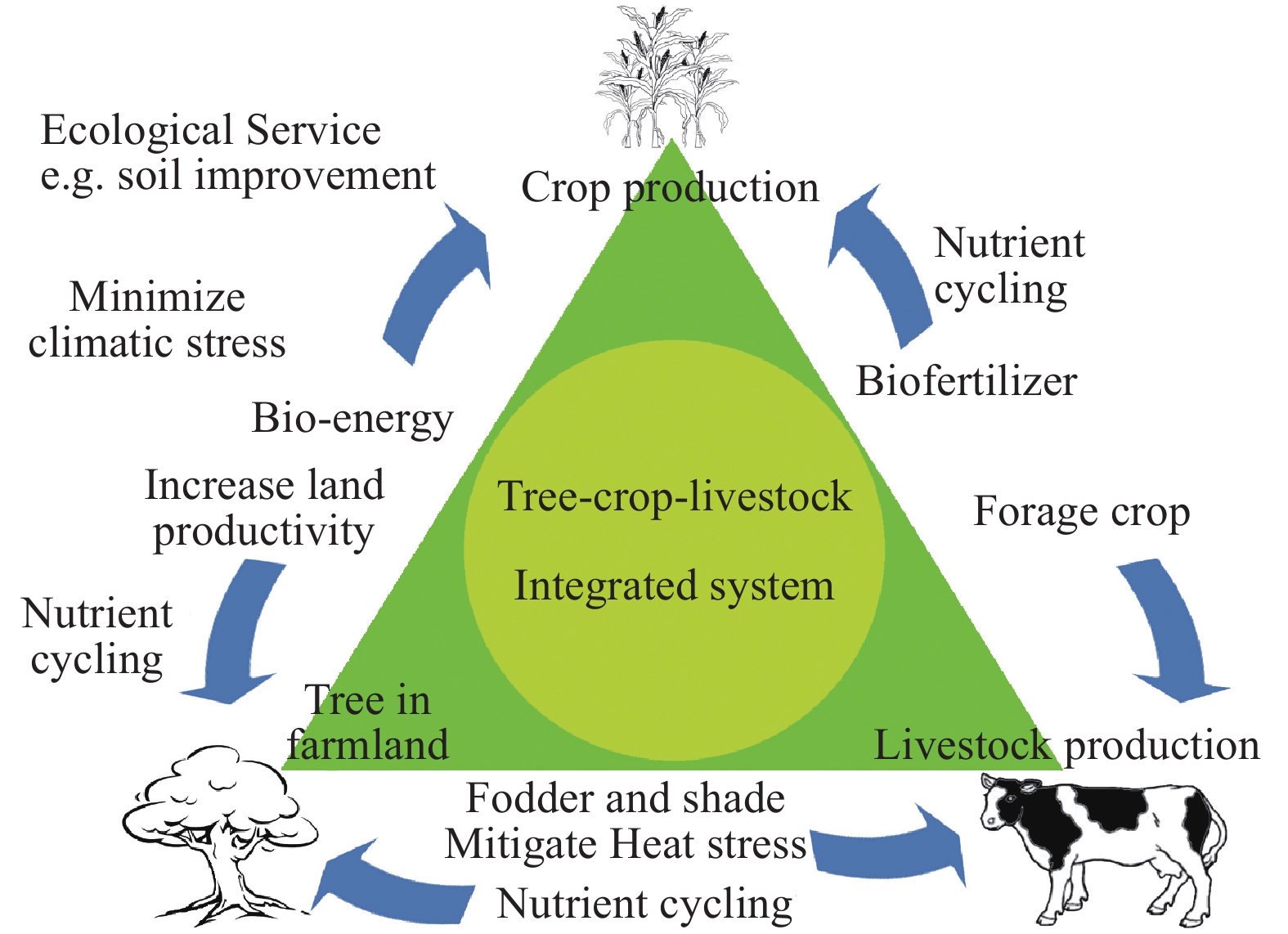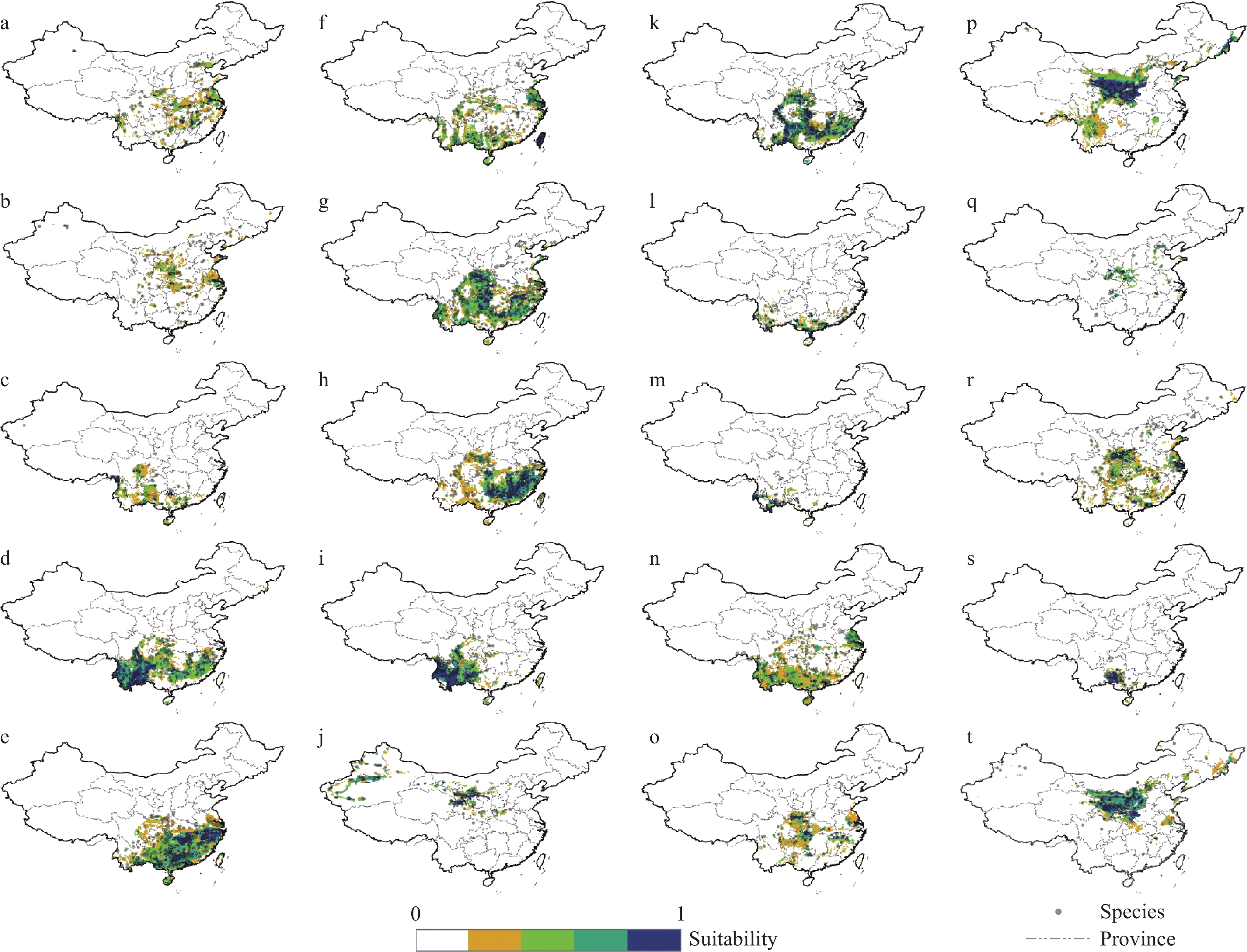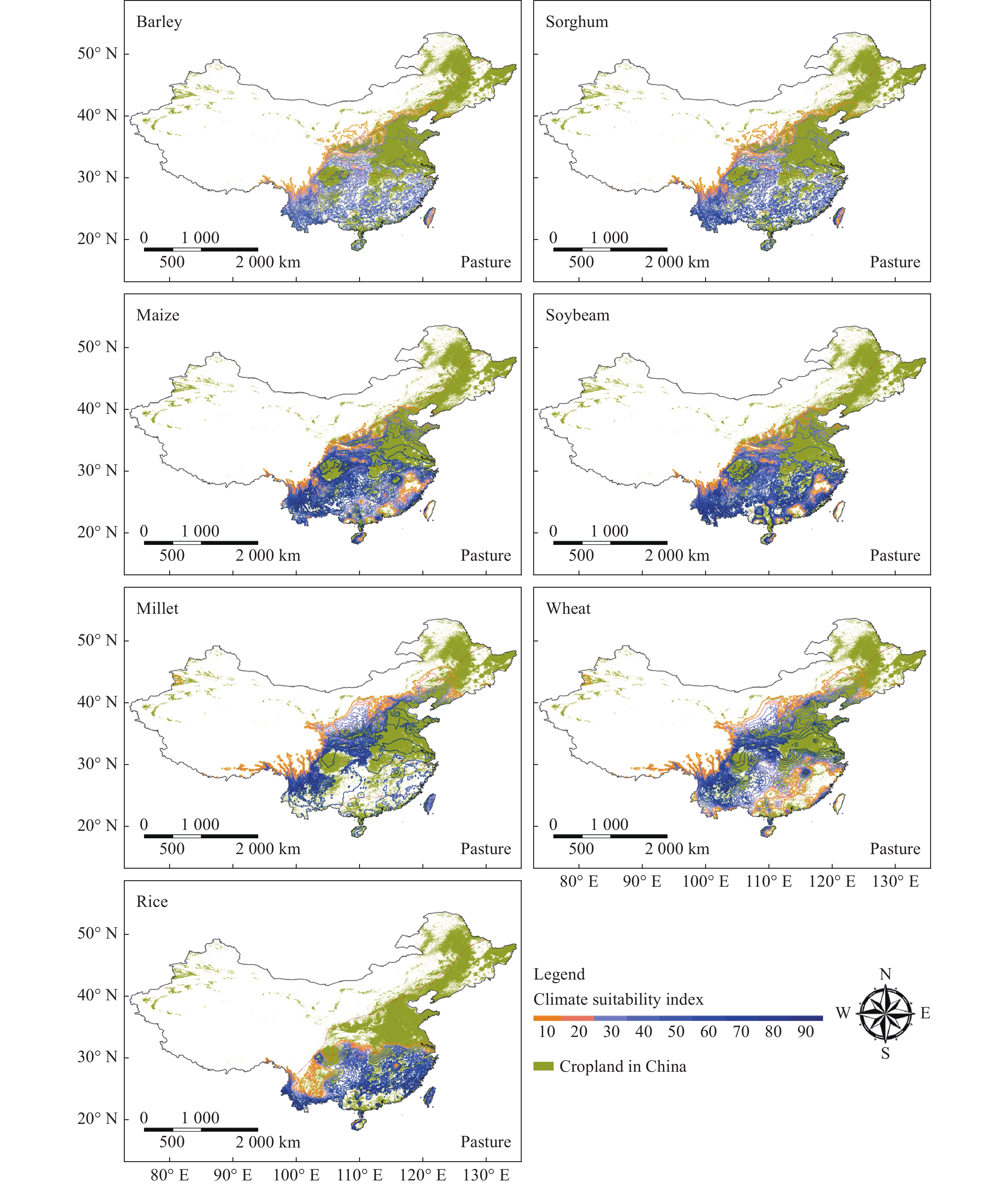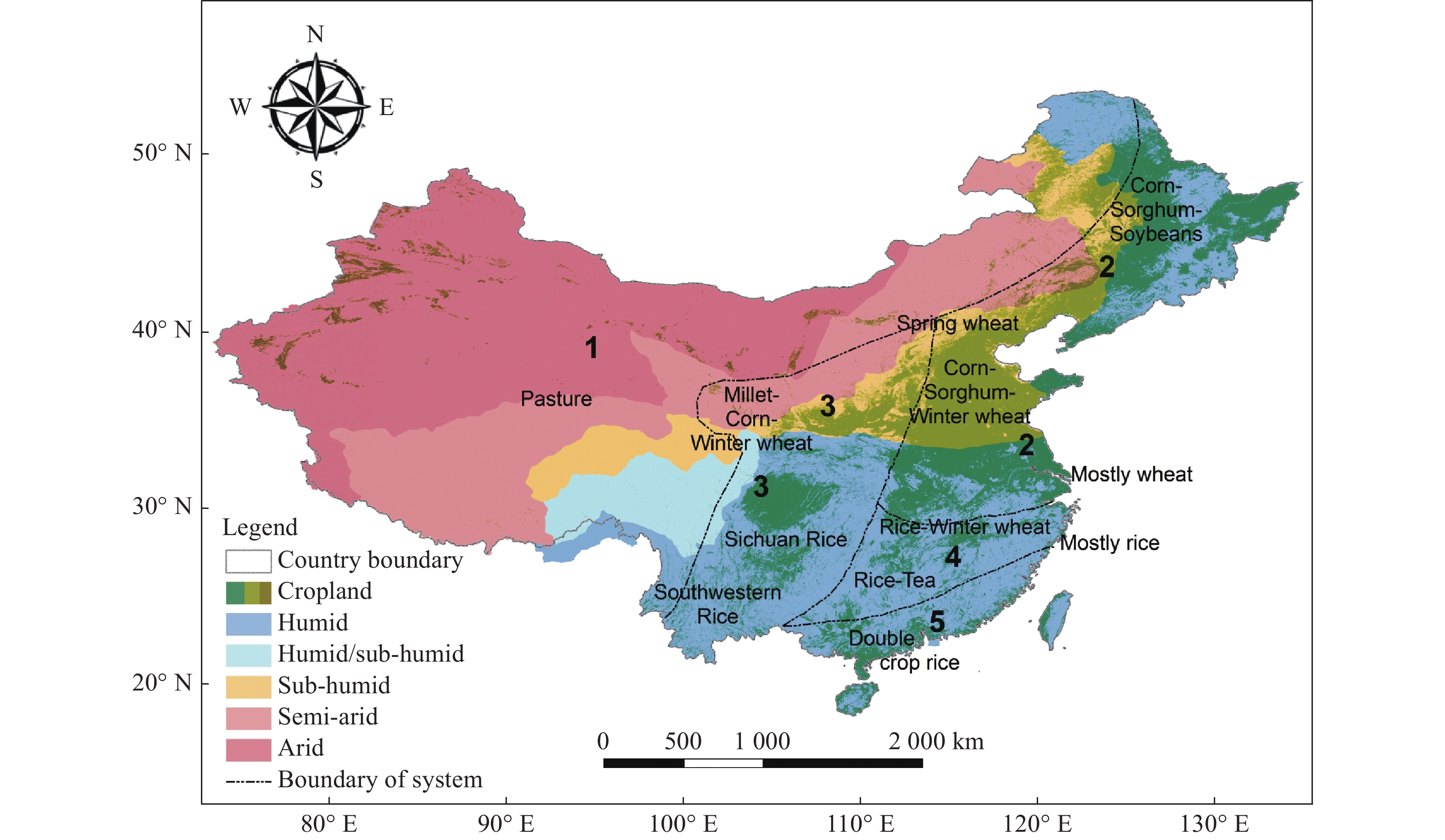-

Figure 1.
Outline of synergy between tree, livestock and crops in cropland.
-

Figure 2.
Consensus mapping based on ensemble modelling. The bioclimatic suitability for each of the selected species, with the observed point distributions overlain. ‘a’ to ‘t’ are species codes for the fodder tree species as listed in Table 2.
-

Figure 3.
Climatic suitability index of important crops in China; Millet include both pearl and foxtail millet.
-

Figure 4.
Major areas suitable for integration of selected fodder trees with crops and livestock. ‘a’ to ‘t’ are species codes for the fodder species as listed in Table 2.
-

Figure 5.
Map of eco-regions, cropland and the crop-livestock production systems in China: 1. systems based on rangeland; 2. systems based on grain crops; 3. systems based on crop/pasture rotations; 4. agro-silvopastoral systems; and 5. systems based on ponds (adapted from Hou et al.[8] and Broxton et al.[52])
-
Species Growth rate Fodder value Soil improvement Potential economic uses Agroforestry Ailanthus altissima Fast High especially for goat, good for silkworm C-sequestration, soil stabilization Medicinal, timber, fuelwood Shelterbelt, potential for cultivation in heavily polluted areas and drought tolerant; known to have allelopathic effect, and therefore, proper management is necessary Amorpha fruticosa Fast High, bee forage N-fixation, Erosion control Medicinal, edible, industrial uses Shelterbelt, tolerates poor sandy soils, dry soils, limey soils, acidic soils Arundo donax Fast High C-sequestration, soil stabilization Bioenergy feedstock, medicinal, thatching Shelterbelt, windbreak, ability to grow in different soil types and climatic conditions Boehmeria clidemioides Fast High Remediate soils with heavy metals contamination Fiber, medicinal Local ethnobotanical value, planted in gullies Boehmeria nivea Fast High Prevent soil erosion Important fiber crop in China, medicinal, edible Planted in gullies Broussonetia papyrifera Fast High Increase phosphorus and nitrogen and improve soil moisture Food, paper making, bioenergy feedstock, fiber, medicinal, timber Shelterbelt and windbreak, economic fallow crop, leading to increased crop production Castanea mollissima Medium High Increase organic matter, nitrogen, phosphorus, and potassium content Edible, bioenergy feedstock, produce utilizable timber every 10 year Alley cropping, silviculture practices, good results from Castanea-tea intercropping Cyclobalanopsis glauca Medium High C-sequestration, improve soil nitrogen Fuelwood, bioenergy feedstock, timber Branch and twigs are good material for mushroom culture Debregeasia orientalis Fast High Improve metal contaminated soil Edible, high-quality fiber Local ethnobotanical value Elaeagnus angustifolia Fast Medium, good bee forage N-fixation, Erosion control or dune stabilization Edible, industrial value, bioenergy feedstock, timber Shelterbelts, windbreaks or protective plantings Ficus heteromorpha Fast Medium Stabilize soil and increase fertility of soil Medicinal, edible, paper making, pig feed Shelterbelts, windbreaks Leucaena leucocephala Fast High, good bee forage N-fixation, C-sequestration Fiber, edible, timber Very good for a maize crop, alley cropping systems Machilus gamblei Fast High, used for Muga silkworm (Antherea assamensis) in NE India N-fixation, C-sequestration Edible, fiber, medicinal, timber, potential for bioenergy feedstock Local ethnobotanical value Morus alba Fast High, good for silkworm Erosion control Edible, industrial value, bioenergy feedstock Shade and shelter, windbreak Populus adenopoda Fast High Increase in soil organic carbon, soil stabilization Timber, fiber, bioenergy feedstock Shade and shelter, windbreak Populus davidiana Fast High Increase in soil organic carbon, soil stabilization Timber, bioenergy feedstock Shade and shelter, windbreak Populus tomentosa Fast High Increase in soil organic carbon, soil stabilization Timber, fiber, bioenergy feedstock Shade and shelter, windbreak Salix babylonica Fast High, bee forage Erosion control Medicinal, fiber, light timber, bioenergy feedstock Shade and shelter, windbreak Saurauia thyrsiflora Fast High Erosion control Edible, medicinal Local ethnobotanical value, high milk production in livestock Ulmus pumila Fast High Erosion control, stabilizing sand dunes Fiber, medicinal, edible, timber Shelterbelt, windbreak, enhance crop production Source: literature listed in ESM 1 Table 1.
Characteristic of selected fodder trees, ethnobotanical notes, and agroforestry uses.
-
GLM MAXENT MAXLIKE RF RPART ENSEMBLE Spp code Spp Weight Weight Weight Weight Weight AUC Kappa maxTPR+TNR a Ailanthus altissima 0.22 0.24 0.22 0.23 0.09 0.84 0.81 0.59 b Amorpha fruticosa 0.25 0.26 0.22 0.26 0 0.82 0.74 0.57 c Arundo donax 0.24 0.25 0.17 0.25 0.09 0.93 0.84 0.6 d Boehmeria clidemioides 0.22 0.22 0.15 0.22 0.19 0.92 0.85 0.48 e Boehmeria nivea 0.2 0.22 0.21 0.22 0.16 0.92 0.89 0.53 f Broussonetia papyrifera 0.23 0.24 0.1 0.24 0.19 0.92 0.82 0.56 g Castanea mollissima 0.21 0.21 0.2 0.21 0.16 0.88 0.83 0.65 h Cyclobalanopsis glauca 0.2 0.21 0.2 0.21 0.18 0.92 0.86 0.51 i Debregeasia orientalis 0.19 0.21 0.21 0.21 0.18 0.95 0.94 0.46 j Elaeagnus angustifolia 0.21 0.22 0.15 0.23 0.18 0.89 0.85 0.61 k Ficus heteromorpha 0.21 0.21 0.21 0.21 0.16 0.91 0.81 0.55 l Leucaena leucocephala 0.24 0.25 0.17 0.26 0.08 0.94 0.93 0.68 m Machilus gamblei 0.21 0.24 0.23 0.23 0.08 0.97 0.97 0.75 n Morus alba 0.25 0.25 0.25 0.24 0 0.84 0.85 0.64 o Populus adenopoda 0.29 0.29 0.05 0.29 0.09 0.89 0.9 0.54 p Populus davidiana 0.22 0.22 0.21 0.23 0.12 0.85 0.89 0.44 q Populus tomentosa 0.21 0.24 0.21 0.26 0.09 0.89 0.81 0.6 r Salix babylonica 0.18 0.26 0.24 0.27 0.06 0.83 0.74 0.55 s Saurauia thyrsiflora 0.19 0.21 0.2 0.21 0.18 0.98 0.97 0.76 t Ulmus pumila 0.22 0.22 0.2 0.22 0.13 0.84 0.86 0.51 NB: sub-model with ‘0’ indicate that particular sub-model was calibrated but not used in the ensemble model. Table 2.
Final weights of each sub-models for ensemble forecasting, AUC, kappa and threshold for ensemble models
-
Absolute Optimum Crop Tmax Tmin Pmax Pmin Tmax Tmin Pmax Pmin Oryza sativa Rice 36 10 4 000 1 000 30 20 2 000 1 500 Sorghum bicolor Sorghum 40 8 3 000 300 35 27 1 000 500 Zea mays Maize 47 10 1 800 400 33 18 1 200 600 Hordeum vulgare Barley 40 2 2 000 200 20 15 1 000 500 Pennisetum glaucum Pearl millet 40 12 1 700 200 35 25 900 400 Setaria italica Foxtail millet 35 5 4 000 300 26 16 700 500 Glycine max Soybean 38 10 1 800 450 33 20 1 500 600 Triticum aestivum Wheat 27 5 1 600 300 23 15 900 750 Tmax − Maximum temperature, Tmin − Minimum temperature in °C; Pmax − Maximum precipitation, Pmin − Minimum precipitation in mm Table 3.
Optimum and absolute range of temperature and precipitation for selected crops.
Figures
(5)
Tables
(3)